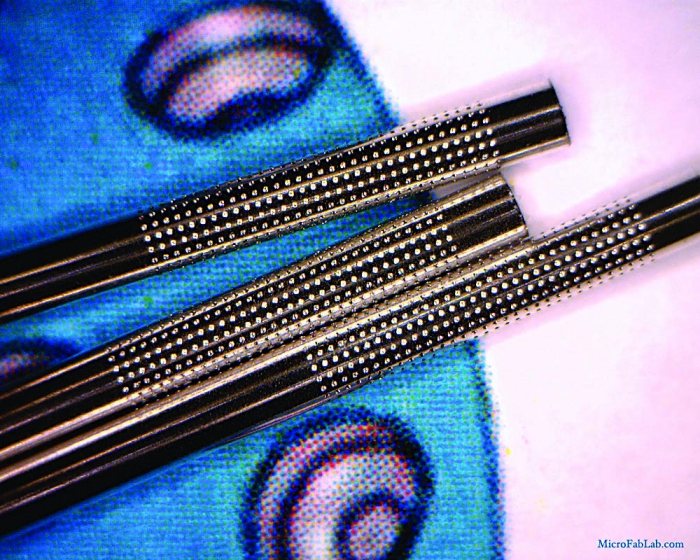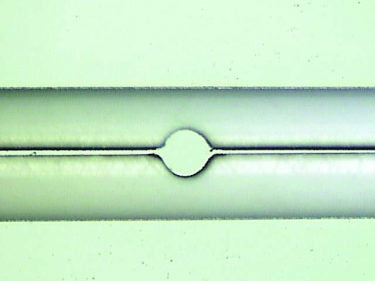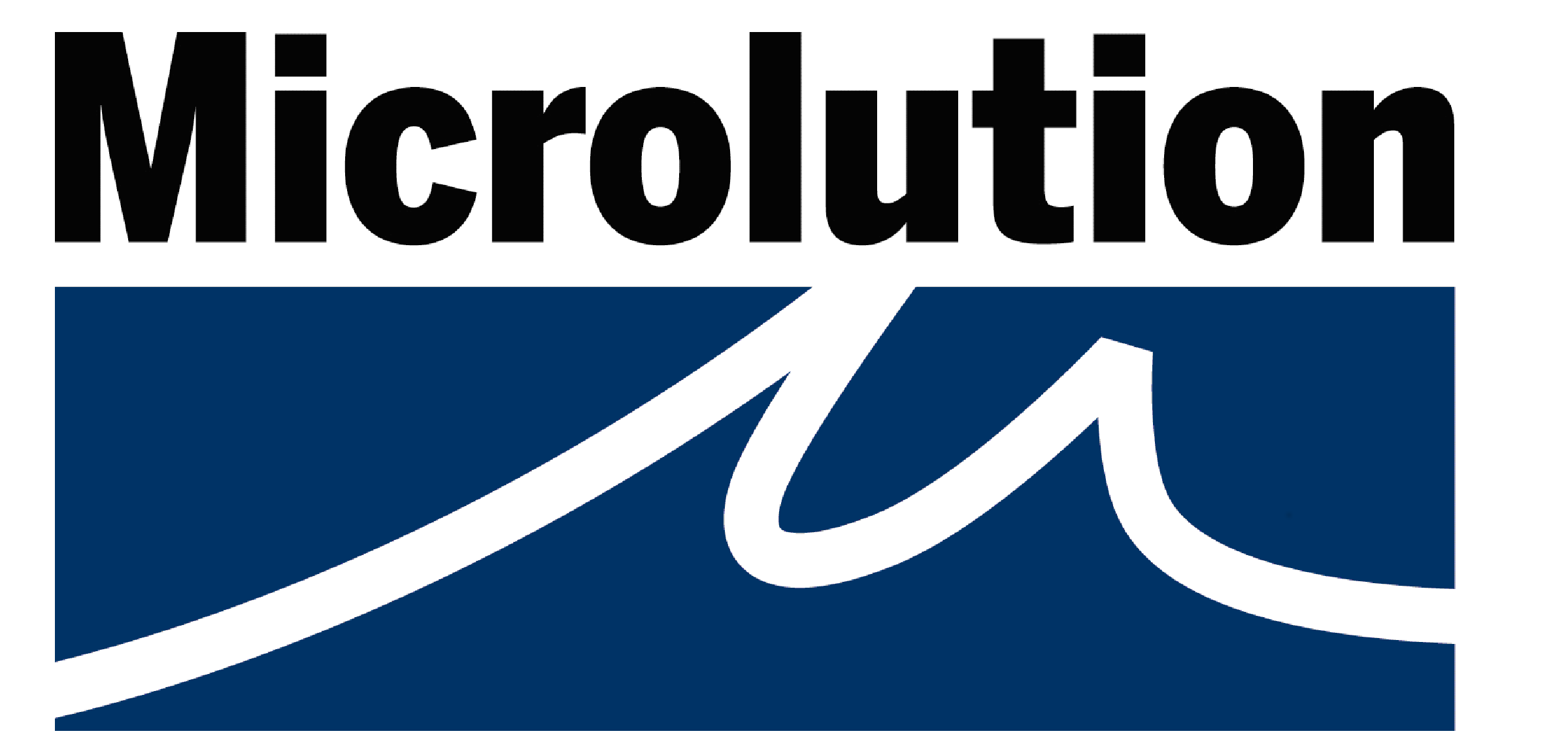A growing number of manufacturers in the medical industry are seeing the light when choosing a machining option for micro parts and features.
The light they’re seeing emanates from laser micromachining systems. They cut faster and cleaner while offering better cut quality than competitive wire EDM, according to Onik Bhattacharyya, director of sales and business development for GF Microlution Inc., Chicago, which builds laser micromachining systems and micromilling machines.
As a result, laser micromachining has “basically taken over some medical parts that have traditionally been done with wire EDM,” Bhattacharyya said, citing, as examples, stents, heart valves and ablation catheter tips. Machined by Microlution laser systems, the catheter tips can be under 4mm (0.157") in overall size with 0.1mm (0.004") features, such as holes and slots.

For these stainless steel medical devices, Potomac Photonics uses a laser to cut the tubes to length and to create wells that measure about 75µm in diameter. Image courtesy of Potomac Photonics.
Bhattacharyya said laser micromachining systems give designers greater freedom “because you can do things with the laser beam much easier than you can with a fine wire.” Drilling an hourglass-shaped hole with a laser, for example, is an “extremely straightforward” process that simply requires the right software program, he said. “But to do that with wire EDM, you would need a specialized system and somebody who knows how to run it well.”
Software-driven lasers provide faster turnaround times than other machining options, said Mike Davis, vice president of manufacturing for Baltimore-based Potomac Photonics, which offers laser micromachining services. “We can take a simple CAD file, quickly load it into the system and cut patterns in a wide variety of materials. The customer can make a change to the file, and we can then put it right back in the system and produce another set of parts. This [flexibility] helps product developers get through iterations so they can bring their products to market more quickly.”
Some of the smallest medical products made by Potomac are devices used to hold implantable lenses in position in the eye. They can be as small as 100µm wide and have features down to 20µm. Potomac also makes larger parts that feature laser-drilled holes down to 2µm in diameter for applications in biotechnology and drug discovery.
No Material Limits
In addition to EDM, laser micromachining competes with many mechanical machining technologies that apply microtools, including chemical etching and electroforming. But these methods have material limitations, noted Igor Lukash, technical director at Gateway Laser Services, a micromachining firm in Maryland Heights, Mo.

The ML-5 is a 5-axis micromachining workstation featuring an ultrafast laser. Image courtesy of GF Microlution.
For example, EDM, chemical etching and electroforming work only with metals. By contrast, Lukash said all materials can be successfully machined with a laser.
Common materials for medical microparts include polymers such as Kapton and PEEK, as well as stainless steel and titanium, according to Potomac’s Davis. For use in medical devices, he said, “we have to be able to clean those materials thoroughly after laser processing so that we don’t leave any debris or residues behind.”
When lasers are used to machine parts made from layers of multiple materials, they can selectively process one layer but not another, which is difficult to do with other machining methods, Lukash said. For example, he cited the production of braided catheter tubing, which encapsulates a metal- or fiber-braided configuration between two polymer layers. In this case, “you want to machine the polymer material only, leaving the braids intact,” he explained.
Medical microparts that are laser-machined by Gateway include gears, seals and washers. According to Lukash, the smallest complete parts fit within a 100µm envelope. The smallest features—mostly holes or slits made in catheters, drug-delivery systems and oxygen-flow regulators—measure less than 25µm.
On the downside, laser micromachining “will lose its competitive advantage over wire EDM pretty quickly” when used to cut material layers thicker than 2mm (0.079"), said Microlution’s Bhattacharyya. “If you get much thicker and don’t have mechanisms to control the shape of the beam and the focus point of the laser, you start losing the machining quality you would get with thinner parts.”

A laser drilled a 0.003"-dia. hole in this thin polyimide tubing used for a catheter. Image courtesy of Gateway Laser Services.
Another major downside of laser micromachining is the cost. Bhattacharyya estimates that the up-front cost of a laser system is probably 50 percent higher, or more, than that of other micromachining options.
On the other hand, he added, Microlution has proven that the total cost of owning a laser micromachining system is “quite a bit less” than that of competitive technologies. This, he said, is because of lower maintenance and consumable costs (laser systems have no wear components comparable to “consumable” wire used in EDM), as well as the reduced post-processing seen with laser-machined parts.
Short Pulses Defeat Heat
In many cases, post-processing has been minimized by the emergence of ultrashort-pulse lasers in machining operations. USPLs emit pulses of light measured in picoseconds (trillionths of a second) or femtoseconds (quadrillionths of a second). The pulses are so short that the so-called heat-affected zone in the machined material is significantly reduced or even eliminated. As a result, little or no post-processing is needed to remove thermal damage.
Picosecond and femtosecond lasers have become more popular in manufacturing settings as their prices have dropped. But they are still far more expensive than standard nanosecond lasers, noted Potomac’s Davis. Each potential user must determine whether the processing advantages USPLs offer are significant enough to justify their expense.
Microlution focuses on integrating femtosecond lasers into its micromachines, along with advanced systems for guiding the laser beam. According to Bhattacharyya, these systems can manipulate the beam in five axes of motion, allowing the creation of a variety of shapes. They also make it possible to control taper, which Bhattacharyya describes as one of the big problems with laser machining. “When we are drilling a hole, we can vary the attack angle of the beam in order to control the taper along the sidewall,” he explained. “If you want a perfectly straight wall, we can give you one.”
Microlution’s 5-axis beam-guiding technology incorporates high-precision galvanometers. A “galvo” incorporates motor-driven mirrors to direct laser light down to the work surface, explained Potomac’s Davis. Thanks to galvos, he said, laser beams can machine an entire area without relying on stage movement, increasing process throughput and repeatability.
As costs come down and the technology improves, laser micromachining should continue to add converts in the medical field—and other fields as well.
Contact Details
Related Glossary Terms
- computer-aided design ( CAD)
computer-aided design ( CAD)
Product-design functions performed with the help of computers and special software.
- electrical-discharge machining ( EDM)
electrical-discharge machining ( EDM)
Process that vaporizes conductive materials by controlled application of pulsed electrical current that flows between a workpiece and electrode (tool) in a dielectric fluid. Permits machining shapes to tight accuracies without the internal stresses conventional machining often generates. Useful in diemaking.
- heat-affected zone
heat-affected zone
That portion of the base metal that was not melted during brazing, cutting or welding, but whose microstructure and mechanical properties were altered by the heat.
- laser machining
laser machining
Intensified, pulsed beams of light generated by lasers—typically carbon dioxide or neodium-doped yttrium aluminum garnet (Nd:YAG)—that drill, weld, engrave, mark, slit and caseharden. Usually under CNC, often at both high cutting rates (100 linear in./sec.) and high power (5kW or more). Lasers also are used in conjunction with in-process quality-control monitoring systems allowing measuring accuracies of 0.00001".
- wire EDM
wire EDM
Process similar to ram electrical-discharge machining except a small-diameter copper or brass wire is used as a traveling electrode. Usually used in conjunction with a CNC and only works when a part is to be cut completely through. A common analogy is wire electrical-discharge machining is like an ultraprecise, electrical, contour-sawing operation.
Contributors
Gateway Laser Services
(314) 785-6800
www.gatewaylaser.com
GF Microlution Inc.
(773) 282-6495
www.microlution-inc.com
Potomac Photonics
(888) 919-1303
www.potomac-laser.com



